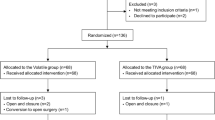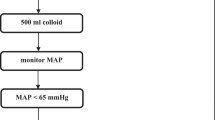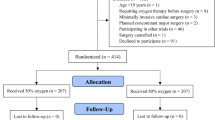Abstract
To retrospectively investigate the effects of indigo carmine intravenous injection on oxygen reserve index (ORi™) in 20 patients who underwent elective gynecologic surgery under general anesthesia. The study subjects were patients who underwent elective gynecologic surgery under general anesthesia between April 2016 and January 2017, and were administered a 5-ml intravenous injection of 0.4% indigo carmine for clinical purposes during surgery with ORi monitoring. Changes in ORi within 20 min after indigo carmine injection were observed. A relevant decrease in ORi was defined as ≥ 10% reduction in ORi from pre-injection level. ORi rapidly decreased after indigo carmine intravenous injection in all patients. In 10 of 19 patients, ORi decreased to 0 after indigo carmine injection. The median lowest value of ORi was 0 (range 0–0.16) and the median time to reach the lowest value of ORi was 2 min (range 1–4 min) after injection. ORi values returned to pre-injection levels within 20 min in 13 of 19 patients, and the median time to return to pre-injection levels was 10 min (range 6–16 min) after injection. During ORi monitoring it is necessary to consider the rapid reduction in ORi after intravenous injection of indigo carmine.
Similar content being viewed by others
Avoid common mistakes on your manuscript.
To the Editor,
The oxygen reserve index (ORi™) [1,2,3] reflects the real-time status of oxygenation under a hyperoxic situation. It is a new oxygenation-related parameter measured by Root™ with Radical-7™ (Masimo Corp., Irvine, CA, USA). With the sensor attached to the finger, percutaneous oxygen saturation (SpO2), percutaneous total hemoglobin level (SpHb), and ORi can be measured. ORi is expressed as a value between 0.00 and 1.00, lacking a unit; it varies according to the oxygen status of the patient. Since it is a new parameter, there are few relevant reports in the literature.
Indigo carmine is an agent that is rapidly excreted in the urine after intravenous injection and is often used for confirming the presence/absence of ureteral lesions during surgery. The influence of indigo carmine on SpO2 has been previously reported [4,5,6,7], and we have reported that SpHb measured by Radical-7 may also be affected by indigo carmine according to the type of the sensor used [8, 9]. However, to the best of our knowledge, there are no reports on the effects of indigo carmine intravenous injection on ORi. Therefore, we conducted a retrospective study to determine the effects of indigo carmine intravenous injection on ORi.
The present study was retrospective in nature and conducted using medical records. The present study was approved by the Ethics Committee at Fukushima Medical University (No. 2997). The requirement for informed consent was waived by the Ethics Committee. In place of obtaining informed consent from the patients, the study details have been disclosed on the website of Fukushima Medical University.
The study subjects were patients who underwent elective gynecologic surgery under general anesthesia between April 2016 and January 2017, and were administered a 5-ml intravenous injection of 0.4% indigo carmine for clinical purposes during surgery with ORi monitoring. The Rainbow™ sensor (R2–25, Revision L, Masimo Corp.) was shielded with a cover to protect it from light exposure, and attached to any of the second to fourth fingers on the contralateral side of the inflatable cuff for noninvasive blood pressure monitoring. The timing of indigo carmine intravenous injection was decided at the discretion of the operator. Data on the time of indigo carmine injection and ORi values of 1-min intervals before and after indigo carmine injection were extracted from the recordings of the automated anesthesia record-keeper ORSYS™ (Philips Electronics Japan, Tokyo). General anesthesia was induced by propofol-remifentanil and rocuronium, and maintained by propofol-remifentanil, sevoflurane-remifentanil, or desflurane-remifentanil. The anesthetic drug administered varied among patients due to the retrospective nature of the study. The items of investigation were age, height, weight, ORi and SpO2 values before and after indigo carmine injection. ORi and SpO2 changes within 20 min after indigo carmine injection were observed. A relevant decrease in ORi was defined as ≥ 10% reduction in ORi from the pre-injection level, similar to SpHb [9].
During the 20 min of the post-injection observation period, no changes in FIO2 were made nor were there any events that may otherwise impact the ORi. In most cases, indigo carmine was intravenously injected just before abdominal closure, once hemostasis in the surgical field and a smooth blood circulation was confirmed. Therefore, no patient required fluid resuscitation. Out of the 20 patients included in the study, one patient had an ORi of < 0.1 before indigo carmine injection and was therefore excluded from the analysis. The evaluable 19 patients had a mean age of 53 ± 14 years, mean height of 157.5 ± 6.0 cm, mean weight of 57.2 ± 11.0 kg, a median FIO2 of 0.36 (range 0.29–0.53) and a median ORi of 0.36 (range 0.14–0.59) before indigo carmine injection. In all patients, ORi decreased rapidly after intravenous injection of indigo carmine (Fig. 1, Table 1). The ORi was reduced to 0 in 10 of the 19 patients. The median lowest value of ORi was 0 (range 0–0.16), and the median time to reach the lowest value of ORi was 2 min (range 1–4 min) after indigo carmine injection. ORi values returned to pre-injection level within 20 min in 13 of the 19 patients, and the median time to return to the pre-injection level was 10 min (range 6–16 min). In contrast, there were no major changes in SpO2 after indigo carmine injection (Table 2).
Changes in ORi after indigo carmine injection were analyzed in this study. Now consider what ORi is in the first place. ORi is a new parameter that indicates the real-time oxygenation status in hyperoxia (partial pressure of oxygen of about 100–200 mmHg). ORi can be measured non-invasively by wearing a sensor on a finger. ORi is an “index” parameter with a unit-less scale between 0.00 and 1.00 and changes according to the oxygenation status of patients [1,2,3, 10].
However, it appears that ORi almost never reaches 1. There is only a short history of ORi measurements in the literature, and its usefulness has only recently started to be discussed. Since a decrease in ORi precedes SpO2, it has potential use as a predictor of decreased oxygenation in rapid sequence induction, and enables the monitoring of excessive oxygenation. Szmuk et al. studied variations in ORi at the time of induction of anesthesia [2]. They investigated the usefulness of ORi during induction of anesthesia in children and reported that ORi rapidly decreased 31.5 s before SpO2 decreased to 98%. However, reports on this index in the present literature are limited.
All SpO2, SpHb, and ORi parameters in the present study were measured by Root with Radical-7. We have previously published three studies on SpHb [8, 9, 11], two of these [8, 9] comprised studies of the effects of indigo carmine injection on SpHb. A rapid decrease in ORi after indigo carmine injection was observed in these studies, which led to the conception of the present study.
The relationships between dyes, and SpO2, SpHb, and ORi, measured by Root with Radical-7, are described below. In regard to the relationship between SpO2 and dyes, it has previously been reported that intravenous injection of dyes such as indigo carmine, methylene blue, and indocyanine green influences SpO2 [4,5,6,7]. Scheller et al. [4] studied this issue using the Nellcor™ pulse oximeter. They examined changes in SpO2 using three dyes; methylene blue, indocyanine green, and indigo carmine, and found that these dyes influence SpO2 to varying degrees. Indigo carmine caused variations in SpO2 in the fewest patients, with the smallest extent of variations, while SpO2 varied to the greatest extent following injection of methylene blue. Concerning the reason for these changes, the authors concluded that SpO2 varied to the greatest extent because the Nellcor pulse oximeter applies light with wavelengths of 660 and 925 nm for measurements, and the absorbance of methylene blue is the highest at around 660 nm. In our study, there were no major changes in SpO2 after indigo carmine injection. The lack of influence of indigo carmine on SpO2 seems to be mostly attributable to improvements in either the device itself or the sensor.
The relationship between SpHb and dyes has been addressed in our previous two studies [8, 9]. With the Revision K sensor [8], prior to the advent of Revision L, SpHb decreased by 1.8 g/dl after intravenous injection of indigo carmine, and it took 4 min for SpHb to reach the lowest level and 15 min to return to the pre-injection level after indigo carmine injection. In addition, depending on the patient, it either took up to 29 min for a return to the pre-injection level or a measured value was not displayed after intravenous injection of indigo carmine. However, with Revision L [9], we did not record an effect of indigo carmine intravenous injection on SpHb. We have also reported that, unlike the Revision K sensor, the Revision L sensor does not influence the measurement of SpHb after indigo carmine intravenous injection.
The present study examined variations in ORi after indigo carmine injection and found a rapid decrease in ORi after injection in all patients. The median time to reach the lowest value of ORi was 2 min (range 1–4 min) after injection. The reduced ORi did not return to the pre-injection level even at 20 min after injection in six patients. This finding should be considered when monitoring ORi. The fact that the wavelength of the ORi measurement is close to the absorbance of indigo carmine may explain the rapid decrease in ORi, as well as SpO2. However, because methods of measurement have not been fully disclosed, further discussion is not feasible.
The usefulness of ORi in various settings may be reported in the future; however, in the meantime, it should be considered that intravenous injection of the dye indigo carmine causes a rapid decrease in ORi. Another dye, methylene blue, also appears to cause a rapid reduction in ORi, although the accumulation of clinical cases is presently insufficient. We intend to examine the effects of other dyes in further accumulated clinical cases.
ORi decreased rapidly in all patients after intravenous injection of indigo carmine. The median lowest value of ORi was 0, the time to reach the lowest value was 2 min, and the median time to return the pre-injection level was 10 min after intravenous injection of indigo carmine. The rapid reduction in ORi after indigo carmine injection should be considered in ORi monitoring.
References
Scheeren TWL, Belda FJ, Perel A. The oxygen reserve index (ORI): a new tool to monitor oxygen therapy. J Clin Monit Comput. 2017. doi: 10.1007/s10877-017-0049-4.
Szmuk P, Steiner JW, Olomu PN, Ploski RP, Sessler DL, Ezri T. Oxygen reserve index a novel noninvasive measure of oxygen reserve—a pilot study. Anesthsiology 2016; 124:779–84. doi: 10.1097/ALN.0000000000001009.
Applegate RL, Dorotta IL, Wells B, Juma D, Applegate PM. The relationship between oxygen reserve index and arterial partial pressure of oxygen during surgery. Anesth Analg. 2016;123:626–33. doi: 10.1213/ANE.0000000000001262.
Scheller MS, Unger RJ, Kelner MJ. Effects of intravenously administered dynes on pulse oximetry readings. Anesthesiology. 1986;65(5):550–1.
Sriganesh K, Vinay B, Bhadrinarayan V. Indocyanine green dye administration can cause oxygen desaturation. J Clin Monit Comput. 2013;27(3):371. doi:10.1007/s10877-012-9423-42.
Sidi A, Paulus DA, Rush W, Gravenstein N, Davis RF. Methylene blue and indocyanine green artifactually lower pulse oximetry readings of oxygen saturation. Studies in dogs. J Clin Monit. 1987;3(4):249–56.
Barker SJ, Tremper KK. Pulse oximetry: applications and limitations. Int Anesthesiol Clin. 1987;25(3):155–75.
Isosu T, Satoh T, Oishi R, Imaizumi T, Hakozaki T, Obara S, Ikegami Y, Kurosawa S, Murakawa M. Effects of indigo carmine intravenous injection on noninvasive and continuous total hemoglobin measurement. J Clin Monit Comput. 2016;30(3):313–6. doi: 10.1007/s10877-015-9719-2.
Isosu T, Obara S, Hakozaki T, Imaizumi T, Iseki Y, Mogami M, Ohashi S, Ikegami Y, Kurosawa S, Murakawa M. Effects of indigo carmine intravenous injection on noninvasive and continuous total hemoglobin measurement with using the Revision L sensor. J Clin Monit Comput. 2017;31(2):485–6. doi:10.1007/s10877-016-9850-8.
Perel A. Non-invasive monitoring of oxygen delivery in acutely ill patients: new frontiers. Ann Intensive Care. 2015;5(1):24. doi:10.1186/s13613-015-0067-7.
Isosu T, Obara S, Hosono A, Ohashi S, Nakano Y, Imaizumi T, Mogami M, Murakawa M. Validation of continuous and noninvasive hemoglobin monitoring bypulse CO-oximetry in Japanese surgical patients. J Clin Monit Comput. 2013;27(1):55–60. doi:10.1007/s10877-012-9397-2.
Funding
The authors do not have a financial relationship with an organization.
Author information
Authors and Affiliations
Corresponding author
Ethics declarations
Conflict of interest
The authors declare that they have no conflict of interest.
Ethical approval
The study protocol has been approved by the Ethics Committee at Fukushima Medical University.
Rights and permissions
About this article
Cite this article
Isosu, T., Yoshida, K., Oishi, R. et al. Effects of indigo carmine intravenous injection on oxygen reserve index (ORi™) measurement. J Clin Monit Comput 32, 693–697 (2018). https://doi.org/10.1007/s10877-017-0064-5
Received:
Accepted:
Published:
Issue Date:
DOI: https://doi.org/10.1007/s10877-017-0064-5





